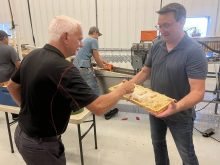Central Alta. facility has helped mountain bluebirds, purple martins, barn swallows and tree swallows make a comeback
Mountain bluebirds have had a sanctuary for decades at the Ellis Bird Farm near Lacombe, Alta., but keeping the sanctuary safe for the birds hasn’t always been easy.
The bluebirds have had to fight off aggressive invasive species like the house sparrow to compete for nesting space.
Charlie Ellis and his sister, Winnie Ellis, became concerned about house sparrows on their farm in the 1950s. Charlie, who had been making a few nesting boxes intended for native song birds, found that house sparrows, an invasive species from Europe, had moved into the convenient new homes and evicted native birds, destroying the eggs and sometimes killing them.
Through trapping, Ellis cleared house sparrows from the area.
Over the decades, Charlie built more nesting boxes, expanding into purple martin houses.
“By 1981, he had 297 nest boxes with nearly 60 nesting pairs,” said Carolyn Ross, site manager and biologist at Ellis Bird Farm.
Mountain bluebird, purple martins, barn swallows and tree swallows have made a comeback at this central Alberta sanctuary.
The brother-and-sister team sold the farm to “Union Carbide under the condition that the bluebirds and land be maintained for farming and wildlife habitat. In 1982, Ellis Bird Farm became a non-profit organization…. Nature Alberta, Red Deer River Naturalists, Lacombe County and Union Carbide were the key participants and currently each organization retains a position on our board of directors. The current operator, MEGlobal, continues to support (Ellis Bird Farm),” said Ross.
The role of Ellis Bird Farm has developed beyond a wildlife sanctuary. For the surrounding farmland, it serves as natural, local pest control because the birds eat only insects. This lessens the pesticides that local grain farmers need to use.
As well, the increased biodiversity the bird farm fosters provides a steady diet for predatory birds like great horned owls, Cooper’s hawks, sharp-shinned hawks, prairie falcons, and peregrine falcons.
In the wider community, Ellis Bird Farm educates the public and helps raise awareness.
“We reach over 1,000 elementary aged schoolchildren through our school programs. We include topics such as biodiversity, agriculture, wetlands and threats to insectivorous birds,” said Ross.
There are special events open to the public, such as Bug Jamboree, Bluebird Festival and presentations on bats. There are also informative displays available to all guests throughout the season.
Monitoring bird behaviour in the face of climate change and pollution is also a function of the farm. Ross’s team and outside research groups use the songbird population to observe changes in nesting, feeding and other habits to learn more about the species and how it interacts with the environment, and to create conditions to help conserve them in their natural state.
The last several years have seen a decline in the cavity nesting songbirds that make Ellis Bird Farm their home.

“Numbers have fluctuated by year and by species. Spring cold snaps here in Alberta and also in the birds’ wintering habitat in Texas and southern (United States) can drastically affect their numbers,” said Ross.
Ross said purple martins overwinter in Brazil, mountain bluebirds migrate to the southern U.S. and central Mexico, and tree swallows migrate to Mexico and other parts of Central America.
Ellis Bird Farm makes sure all nesting boxes have been cleaned out after the young have left the nest. Farm workers carry out repairs and build new boxes that had not survived the prairie winter.
Ellis Bird Farm can see 12,000 visitors come through its gates each year. Aside from its role as a haven for native songbirds and a source for education, the farm is a place of solitude that many people seek to escape the noise of urban life. The restful quiet surrounded by bird song can provide the perfect escape, especially with the farm’s on-site cafe.
Ellis Bird Farm opens for the May long weekend every year.

















